Owls in Arizona is home to various fascinating wildlife, including several species of owls. From the smallest elf owl to the majestic great horned owl, these birds of prey are a common owl sight in the state’s diverse habitats, from urban parks to remote wilderness areas.
These nocturnal hunters are known for their distinctive calls, sharp talons, and keen senses. They are an essential part of the ecosystem, helping to control rodent populations and maintain a healthy balance of prey and predators. Despite their popularity among birdwatchers and nature enthusiasts, owls face many challenges in Arizona, including habitat loss, drought, and pollution. To learn more about these fascinating creatures and how to observe and protect them, read on for our guide to owls in Arizona.
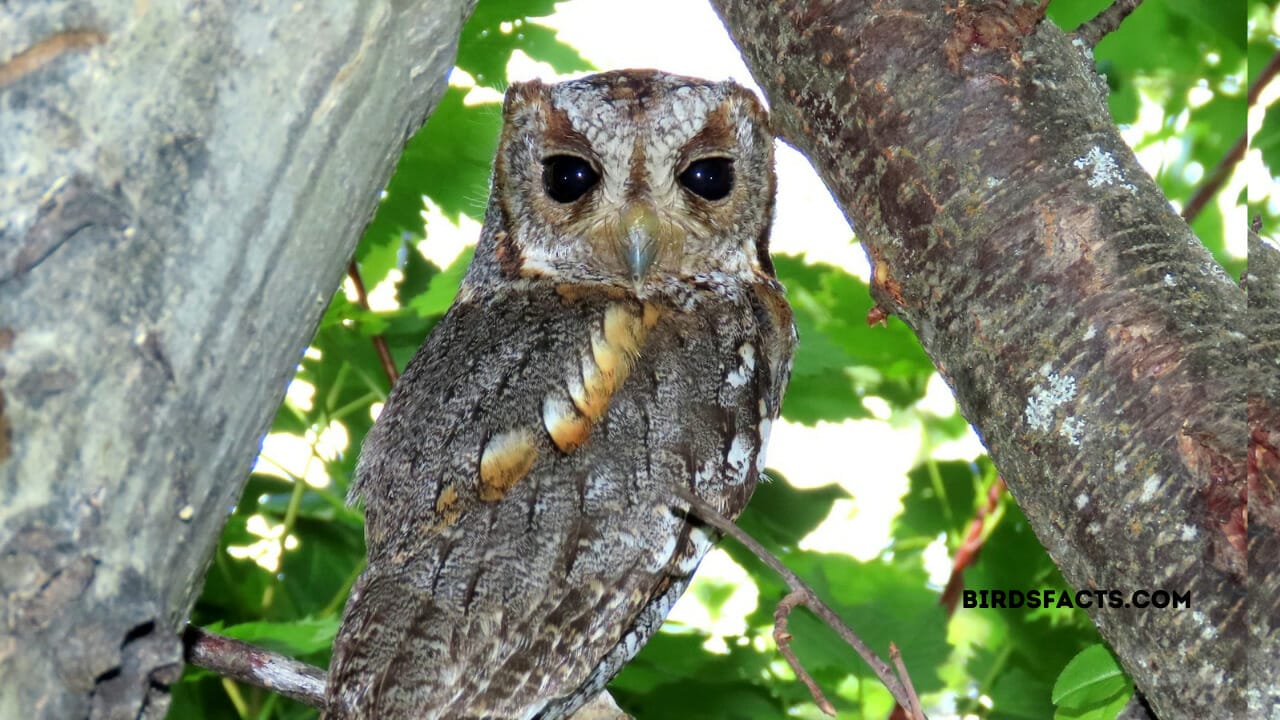
Owls in Arizona
- Owls are Small and a common sight in Arizona’s diverse habitats
- They are known for their distinctive calls, sharp talons, and keen senses
- Owls play an essential role in the ecosystem by controlling rodent populations and maintaining a healthy balance of prey and predators
- Owls in Arizona face many challenges, including habitat loss, drought, and pollution.
Owls In Arizona
- GREAT HORNED OWL
- BARN OWL
- LONG-EARED OWL
- SHORT-EARED OWL
- NORTHERN SAW-WHET OWL
- WESTERN SCREECH OWL
- WHISKERED SCREECH OWL
- MEXICAN SPOTTED OWL
- NORTHERN PYGMY OWL
- FERRUGINOUS PYGMY OWL
- FLAMMULATED OWL
- BURROWING OWL
- ELF OWL
Great Horned Owl
The Great Horned Owl, known by its scientific name Bubo virginianus, is a powerful and majestic bird of prey throughout North and South America. Its diet consists of various animals, including rodents, rabbits, birds, and even skunks. An interesting fact about this owl is that it can turn its head 270 degrees. The estimated population size of the Great Horned Owl is about 10 million individuals, but their biggest threat is habitat loss due to deforestation and urbanization.
The most distinctive feature of the Great Horned Owl is its large ear tufts, which are not ears but are used for communication and camouflage. Other names for this owl include “hoot owl” or “tiger owl.” Its wingspan can reach up to 5 feet and has an incubation period of about 30 days. The Great Horned Owl can be found in various habitats, including forests, deserts, and suburban areas. Its predators include other large birds of prey, such as eagles and hawks. This owl is a type of raptor, or bird of prey, known for its aggressive hunting behavior.
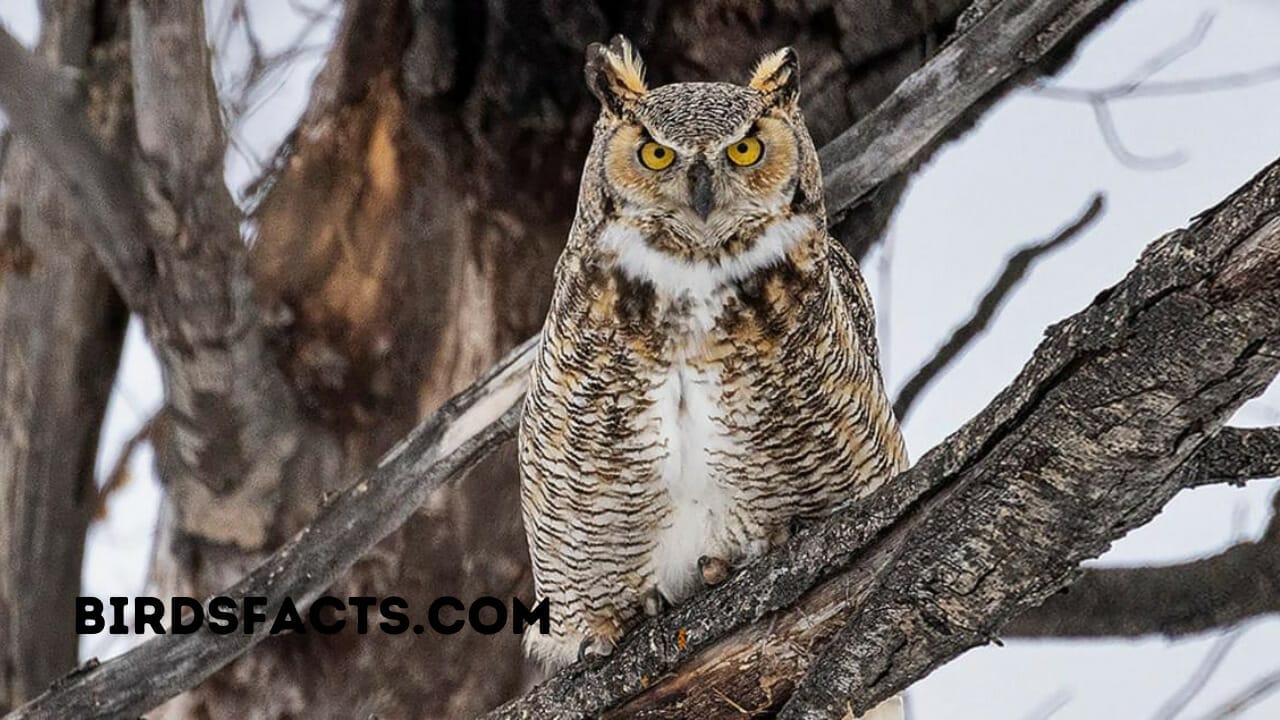
are there owls in arizona
The Great Horned Owl is among the most common owls, with around 20 subspecies. These owls nest in various locations, including tree cavities, abandoned buildings, and even on the ground. They typically molt at around one year old and can live up to about 13 years in the wild. The Great Horned Owl can weigh between 2 and 5 pounds and gain 25 inches in belongs, indeed a magnificent species to behold.
| Information | Description |
|---|---|
| Common Name | Great Horned Owl |
| Scientific Name | Bubo virginianus |
| Habitat | North and South America, including forests, deserts, and suburban areas |
| Diet | Rodents, rabbits, birds, skunks, and various other animals |
| Distinctive Feature | Large ear tufts (used for communication and camouflage) |
| Other Names | Hoot Owl, Tiger Owl |
| Wingspan | Up to 5 feet |
| Head Rotation Ability | Can turn its head 270 degrees |
| Estimated Population Size | Approximately 10 million individuals |
| Threats | Habitat loss due to deforestation and urbanization |
| Predators | Other large birds of prey (eagles, hawks) |
| Reproduction | Incubation period: about 30 days; Nesting locations: tree cavities, abandoned buildings, and sometimes on the ground; Molting: around one year old |
| Lifespan | Up to about 13 years in the wild |
| Weight | Between 2 and 5 pounds |
| Size | Approximately 25 inches in length |
| Subspecies | Around 20 subspecies |
Barn Owl
The Barn Owl, also known as Tyto alba, is a species of owl found worldwide except for Antarctica. A nocturnal bird preys on small mammals such as mice, voles, and shrews. One fun fact about the Barn Owl is that they have exceptional hearing, their ears are asymmetrical, and when they tilt their head, they can accurately locate their prey. The estimated population size of the Barn Owl is challenging to determine, but it is believed to be in decline due to habitat loss and fragmentation.
The biggest threat to this bird is habitat loss, as they rely on open fields and grasslands for hunting. The most distinctive feature of the Barn Owl is its heart-shaped white face with dark eyes, making it easy to distinguish from other owl species. They are also known as the Ghost Owl or the Church Owl due to their silent flight and historical association with churches. The wingspan of a Barn Owl can reach up to 44 inches, and incubation takes about a month. They are commonly found in agricultural fields, meadows, and grasslands, and their predators include larger birds of prey such as eagles and hawks. Their diet consists mainly of small mammals, but they occasionally eat insects and other birds.
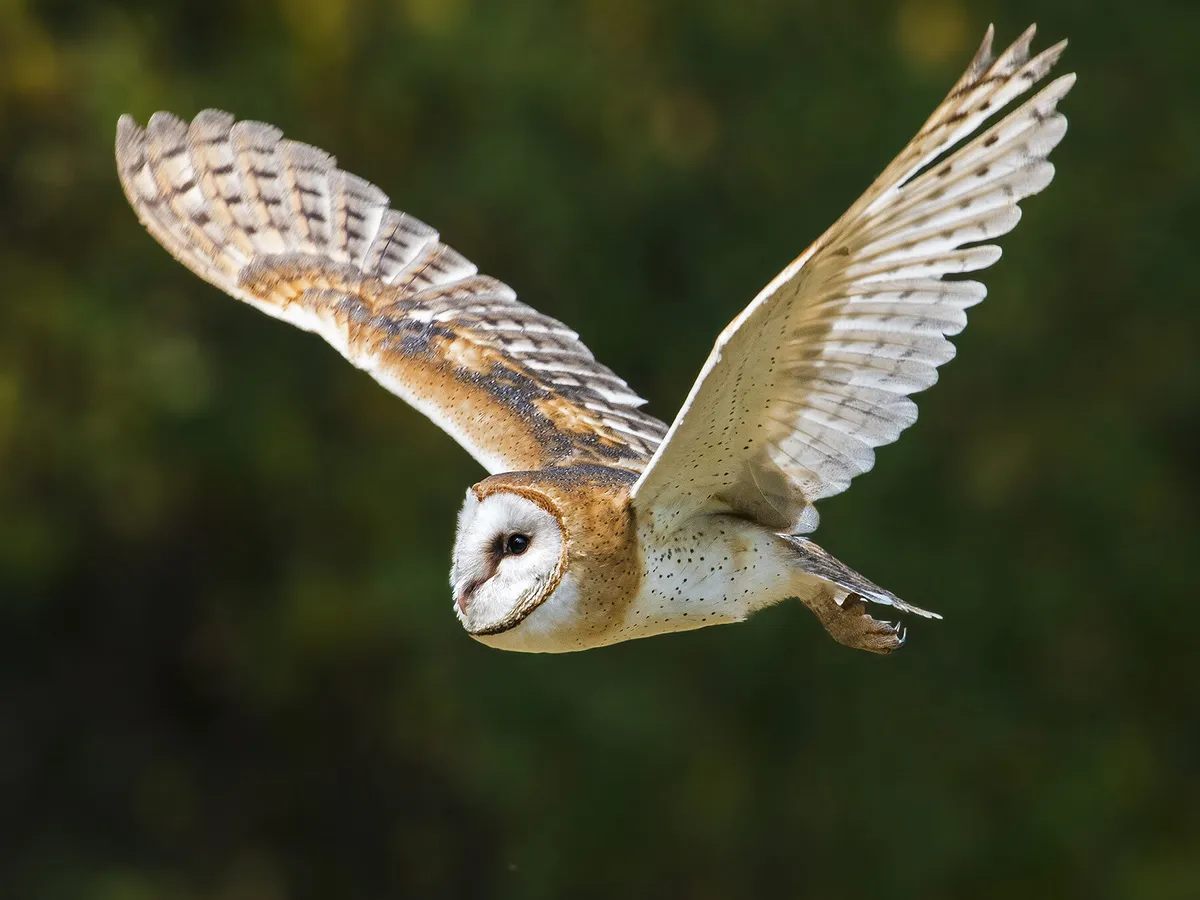
owl species in arizona
The Barn Owl is a type of owl and one of the world’s most widespread bird species. It can live up to 20 years in the wild and weighs around 350-400g, with a length of 33-39 cm. They molt annually, usually in their first year. Their skin type is covered with feathers, and can fly at 50 mph or more. Overall, the Barn Owl is a unique and fascinating bird that is essential to our ecosystem.
| Information | Value |
|---|---|
| Common Name | Barn Owl |
| Scientific Name | Tyto alba |
| Distribution | Worldwide (except Antarctica) |
| Habitat | Open fields, grasslands, agricultural fields, meadows, and grasslands |
| Prey | Small mammals (mice, voles, shrews), occasionally insects and birds |
| Hunting Behavior | Nocturnal |
| Unique Feature | Exceptional hearing, asymmetrical ears, accurate prey location |
| Population Status | Estimated decline due to habitat loss and fragmentation |
| Biggest Threat | Habitat loss |
| Distinctive Feature | Heart-shaped white face with dark eyes |
| Alternative Names | Ghost Owl, Church Owl |
| Wingspan | Up to 44 inches |
| Incubation Period | Approximately one month |
| Predators | Larger birds of prey (eagles, hawks) |
| Lifespan | Up to 20 years in the wild |
| Weight | Around 350-400g |
| Length | 33-39 cm |
| Molting | Annually, usually in the first year |
| Flight Speed | 50 mph or more |
| Ecosystem Role | Essential |
Long-eared Owl
The long-eared owl, Asio otus, is a species that inhabits forests and woodlands across North America, Europe, and Asia. These birds of prey are characterized by their large wingspan, which can reach up to 40 inches, and their distinctive features, such as long ear tufts and yellow eyes. Long-eared owls live as a relatively Owl is small species, weighing only around 11 ounces and measuring up to 15 inches in length.
Their diet mainly consists of rodents, but they also feed on insects, birds, and small mammals. They are typically nocturnal and hunt at night, using their keen senses of sight and hearing to locate their prey. During the day, they roost in dense foliage or tree cavities.
The long-eared owl’s most distinctive feature is its tufted ears. These tufts are not ears but rather feathers that serve as camouflage and can be raised or lowered depending on the bird’s mood or level of alertness. Another distinctive feature is its silent flight, which allows the owl to sneak up on its prey undetected.
These birds are also known as “cat owls” due to their resemblance to cats, both in appearance and behavior. They have a top speed of around 30 mph and can live up to 14 years in the wild. Their estimated population size is around 200,000 individuals worldwide, with the biggest threat to their survival being habitat loss and degradation. Young long-eared owls start molting when they are around 12 weeks old, and their feathers turn from white to reddish-brown as they mature.
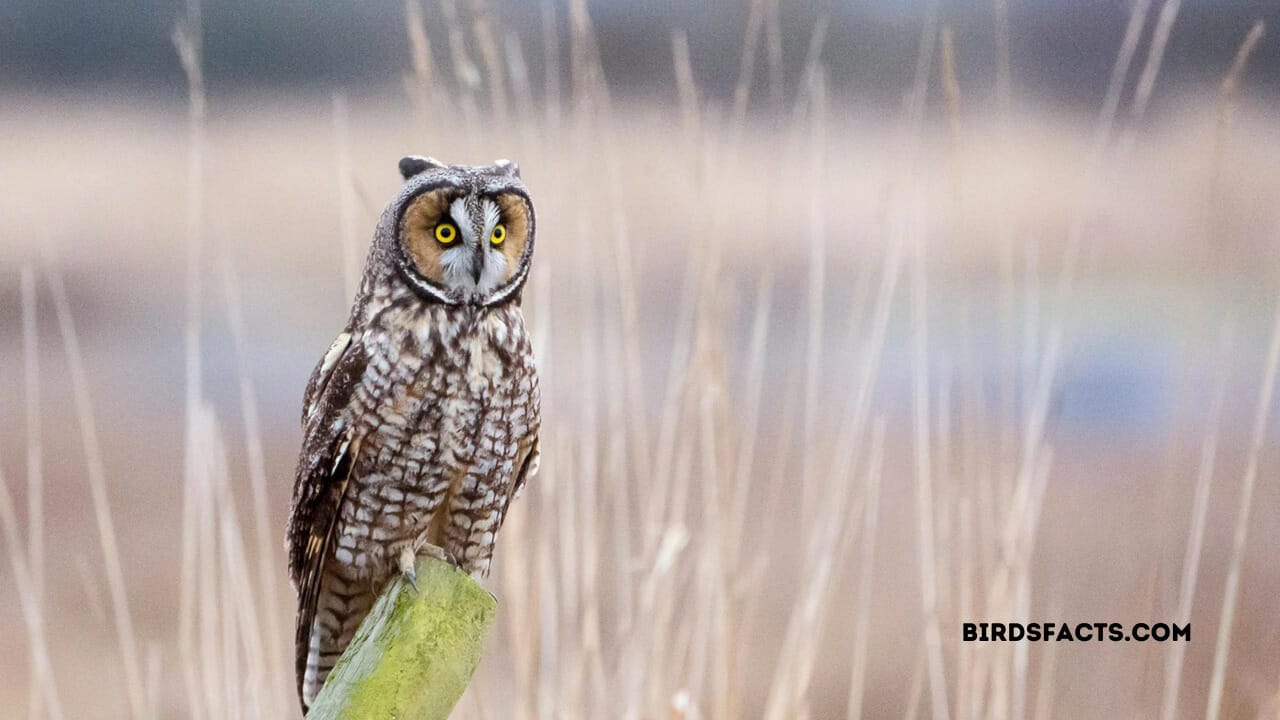
types of owls in arizona
Long-eared owls typically mate and nest in the exact location each year, producing a clutch of 4-7 eggs that are incubated for around 25-30 days. The nesting location is usually in dense foliage or tree cavities, providing safety and protection for the young. Despite their nocturnal habits, long-eared owls are susceptible to predation from larger birds of prey, such as eagles and hawks.
| Species Name | Long-eared Owl (Asio otus) |
|---|---|
| Habitat | Forests and woodlands in North America, Europe, and Asia |
| Wingspan | Up to 40 inches |
| Distinctive Features | Long ear tufts, yellow eyes, tufted ears (feathers) that can be raised or lowered |
| Size | Weight: Approximately 11 ounces |
| Length: Up to 15 inches | |
| Diet | Mainly rodents, also insects, birds, and small mammals |
| Activity Pattern | Nocturnal |
| Hunting Behavior | Relies on keen senses of sight and hearing; hunts at night |
| Roosting | Dense foliage or tree cavities during the day |
| Silent Flight | Allows the owl to approach prey silently and undetected |
| Resemblance | Known as “cat owls” due to resemblance to cats in appearance and behavior |
| Top Speed | Around 30 mph |
| Lifespan | Up to 14 years in the wild |
| Population Size | Estimated around 200,000 individuals worldwide |
| Threats | Habitat loss and degradation |
| Molting | Starts at approximately 12 weeks old; feathers turn from white to reddish-brown as they mature |
| Reproduction | Mates and nests in the same location each year; produces a clutch of 4-7 eggs; incubation period: 25-30 days |
| Nesting Location | Dense foliage or tree cavities for safety and protection |
| Predators | Vulnerable to predation from larger birds of prey, such as eagles and hawks |
Short-Eared Owl
The Short-Eared Owl, also known as Asio flammeus, is a fascinating bird of prey found in various habitats across the Northern Hemisphere. These birds mainly prey on small rodents, such as mice and voles, but they have also been known to feed on birds, insects, and even fish. With an estimated population size of around one million individuals, the biggest threat to Short-Eared Owls is habitat loss and degradation.
One of the most distinctive features of the Short-Eared Owl is its facial disk, which is a flat circular area of feathers that helps to focus sound towards the owl’s ears. This adaptation makes locating prey in the dark easier for the barred owl. Some other interesting facts about these owls include their tendency to roost on the ground or low branches rather than in trees and their ability to incubate their eggs through their feet. Short-Eared Owls have a wingspan of around 3 feet and can nest in various locations, including grassy fields, marshes, and tundra.
Short-Eared Owls have several predators, including larger birds of prey and mammals such as foxes and weasels. However, their most significant danger comes from human activity that destroys their habitats through land development or agricultural conversion. Despite this threat, Short-Eared Owls are nocturnal able to live for up to ten years in the wild and can reach speeds of up to 40 miles per hour in flight. They molt and change color as they age, from a mottled brown and white as juveniles to a more uniform reddish-brown as adults.
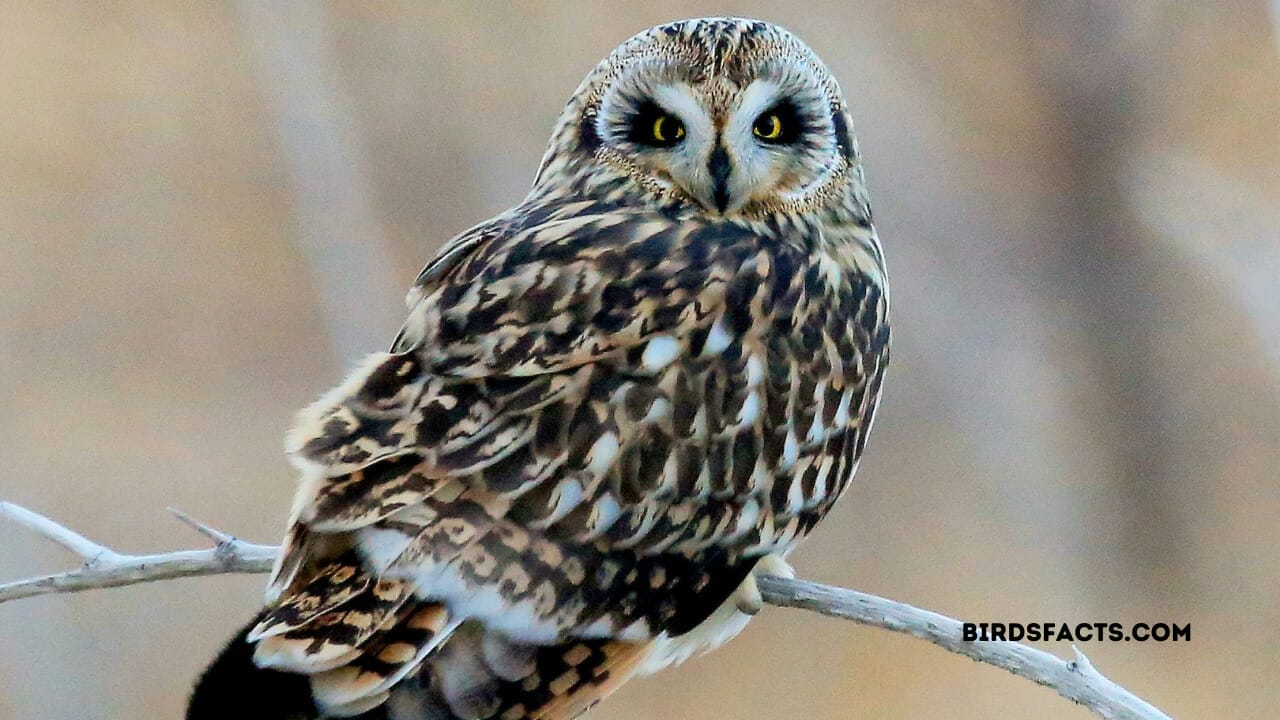
white owls in arizona
Overall, the Short-Eared Owl in the world is a fascinating bird with unique adaptations and behaviors. From their facial disk to their ground-level roosting habits, these owls have several traits that set them apart from other birds of prey. As human activity continues to impact their habitats, efforts to protect these birds and their ecosystems will be crucial for ensuring their survival.
| Attribute | Information |
|---|---|
| Common Name | Short-Eared Owl |
| Scientific Name | Asio flammeus |
| Habitat | Various habitats across the Northern Hemisphere |
| Diet | Mainly small rodents (mice and voles), birds, insects, and fish |
| Population Size | Approximately one million individuals |
| Threats | Habitat loss and degradation |
| Distinctive Feature | Facial disk for focusing sound towards the ears |
| Roosting Habits | Ground or low branches rather than trees |
| Incubation Method | Ability to incubate eggs through their feet |
| Wingspan | Around 3 feet |
| Nesting Locations | Grassy fields, marshes, tundra |
| Predators | Larger birds of prey, foxes, weasels |
| Human Impact | Habitat destruction through land development and agricultural conversion |
| Lifespan | Up to ten years in the wild |
| Flight Speed | Up to 40 miles per hour |
| Molting | Changes color as they age, from mottled brown and white as juveniles to a more uniform reddish-brown as adults |
| Significance | Fascinating bird with unique adaptations and behaviors |
| Conservation Efforts | Crucial for protecting the species and their ecosystems |
Northern saw-whet Owl
The Northern Saw-Whet Owl, scientific name Aegolius acadicus, is small-sized in North America. This species preys on small mammals, birds, and insects. A fun fact about the Northern Saw-Whet Owl is that they get their name from the sound their call makes, which sounds like a saw being sharpened on a whetstone. The estimated population size of this owl is challenging to determine since they are mainly nocturnal and elusive.
The biggest threat to the Northern Saw-Whet Owl is habitat loss due to deforestation, urbanization, and agriculture. The most distinctive feature of this owl is its large, round head and big, expressive eyes. Other names for this species include Acadian Owl and Acadian Saw-Whet Owl. The Northern Saw-Whet Owl has a wingspan of about 17 inches and an incubation period of approximately 26 days. This species typically inhabits coniferous forests and can be preyed upon by more giant owls and hawks. The Northern Saw-Whet Owl is a predatory bird that feeds on various animals, such as rodents, small birds, and insects.
This owl is classified as a true owl and is one of the smallest species of owls in North America. The Northern Saw-Whet Owl is one of the 19 owls in North America and is found in many parts of the continent. They nest in tree cavities and usually only molt after their first year. The color of their feathers ranges from brown to gray, and their skin type is covered in soft feathers.
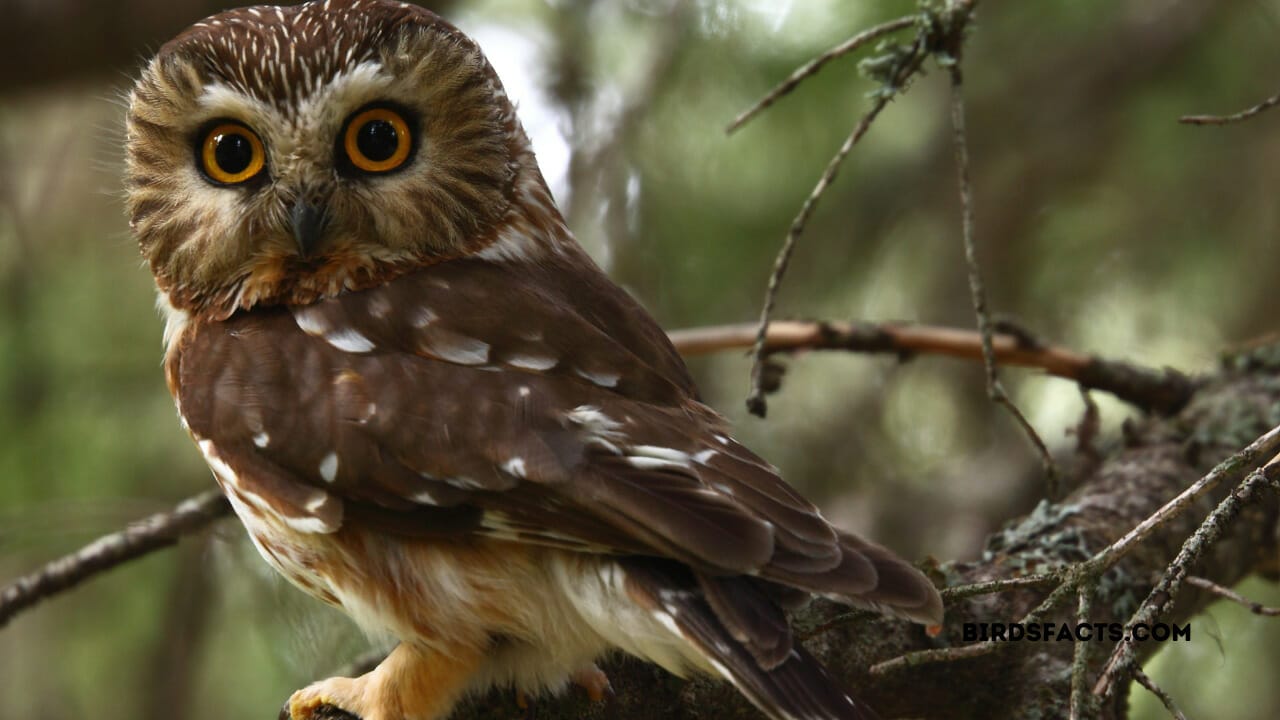
owls of arizona
This owl’s top speed is unknown, but they are known to be slow and stealthy fliers. The lifespan of the Northern Saw-Whet Owl is about four to five years in the wild, and they weigh only one to four ounces and are nearly six to eight inches long.
| Attribute | Information |
|---|---|
| Scientific Name | Aegolius acadicus |
| Size | Small-sized |
| Habitat | Coniferous forests |
| Prey | Small mammals, birds, insects |
| Population Size | Challenging to determine |
| Threats | Habitat loss (deforestation, urbanization, agriculture) |
| Distinctive Feature | Large, round head and big, expressive eyes |
| Other Names | Acadian Owl, Acadian Saw-Whet Owl |
| Wingspan | Approximately 17 inches |
| Incubation Period | Approximately 26 days |
| Predators | Larger owls, hawks |
| Classification | True owl |
| Size in North America | One of the smallest species of owls |
| Distribution | Found in many parts of North America |
| Nesting Habits | Tree cavities |
| Molting | Usually only after the first year |
| Feather Color | Brown to gray |
| Skin Type | Covered in soft feathers |
| Speed | Unknown |
| Lifespan (Wild) | Approximately 4-5 years |
| Weight | 1-4 ounces |
| Length | Nearly 6-8 inches |
Western Screech-Owl
The Western Screech-Owl, scientifically known as Megascops kennicottii, is a bird species found in North America. They primarily prey on small rodents, insects, and other small birds. Interestingly, Western Screech-Owls can mimic other bird species, making it difficult for predators to locate them. The estimated population size of Western Screech-Owls is around 400,000 individuals. Their biggest threat is habitat loss due to urbanization and deforestation.
The most distinctive feature of this bird species is the feather tufts on their heads, which can be raised or lowered to communicate their mood. Other names for Western Screech-Owls include Dwarf Screech-Owl and Kennicott’s Screech-Owl. Their wingspan typically ranges between 18-24 inches, and their incubation period is around 27 days. These birds can be found in various habitats, including forests, woodlands, and deserts. Some of their predators include larger birds of prey, such as hawks and eagles.
As for their diet, Western Screech-Owls hunt primarily at night and consume a variety of prey, including insects, small mammals, and birds. They are a type of owl, and their common name reflects their distinctive screeching call. There are about 20 species of screech owls worldwide. Western Screech-Owls typically nest in cavities like those found in trees or cliffs. These birds start molting at around six months of age.

owls in az
Their coloration ranges between brown, gray, and cream colors, and they have soft feathers. Their top speed is unknown, and they typically live around six years old in the wild. Western Screech-Owls weigh 5-7 ounces and are typically around nine inches long. Overall, Western Screech-Owls are fascinating birds with unique adaptations for survival in their habitat.
| Species Name | Western Screech-Owl |
|---|---|
| Scientific Name | Megascops kennicottii |
| Habitat | Forests, woodlands, deserts |
| Predators | Larger birds of prey (hawks, eagles) |
| Population Size | Approximately 400,000 individuals |
| Threats | Habitat loss due to urbanization and deforestation |
| Distinctive Feature | Feather tufts on the head that can be raised or lowered |
| Other Names | Dwarf Screech-Owl, Kennicott’s Screech-Owl |
| Wingspan | 18-24 inches |
| Incubation Period | Around 27 days |
| Diet | Insects, small rodents, and small birds |
| Hunting Time | Primarily at night |
| Nesting Behavior | Nest in cavities (trees or cliffs) |
| Molting | Starts at around six months of age |
| Coloration | Brown, gray, cream |
| Feathers | Soft |
| Top Speed | Unknown |
| Lifespan | Around six years in the wild |
| Size | 5-7 ounces, approximately nine inches long |
Whiskered Screech-Owl
The Whiskered Screech-Owl, scientifically known as Megascops trichiasis, is a small owl species found in Central America and parts of South America. This nocturnal bird species prey on small animals such as insects, rodents, and birds. A fun fact about the Whiskered Screech-Owl is that they can rotate their head 270 degrees.
The estimated population size of the species has yet to be well known, but it is believed to be stable. However, habitat loss and poaching are the biggest threats to the species. Its most distinctive feature is the long, bristly feathers around its beak that resemble whiskers. The Whiskered Screech-Owl is also known by other names such as Trilling Screech-Owl and Tropical Screech-Owl. The wingspan of the Whiskered Screech-Owl can range from 41 to 47 centimeters.
The incubation period for the species is around 28 days. The habitat of the Whiskered Screech-Owl ranges from tropical forests to dry and scrubby areas. The species faces predators such as other birds of prey and snakes. As for diet, the Whiskered Screech-Owl is a carnivorous species that feeds mainly on insects, small mammals, and birds. They belong to the owl family Strigidae and are a type of owl. The Whiskered Screech-Owl is one of the common names for the species. There are around 300 species of owls globally, and the Whiskered Screech-Owl is one of them. Their nesting locations vary but are usually found in tree cavities. The age of molting for the species is around six weeks.
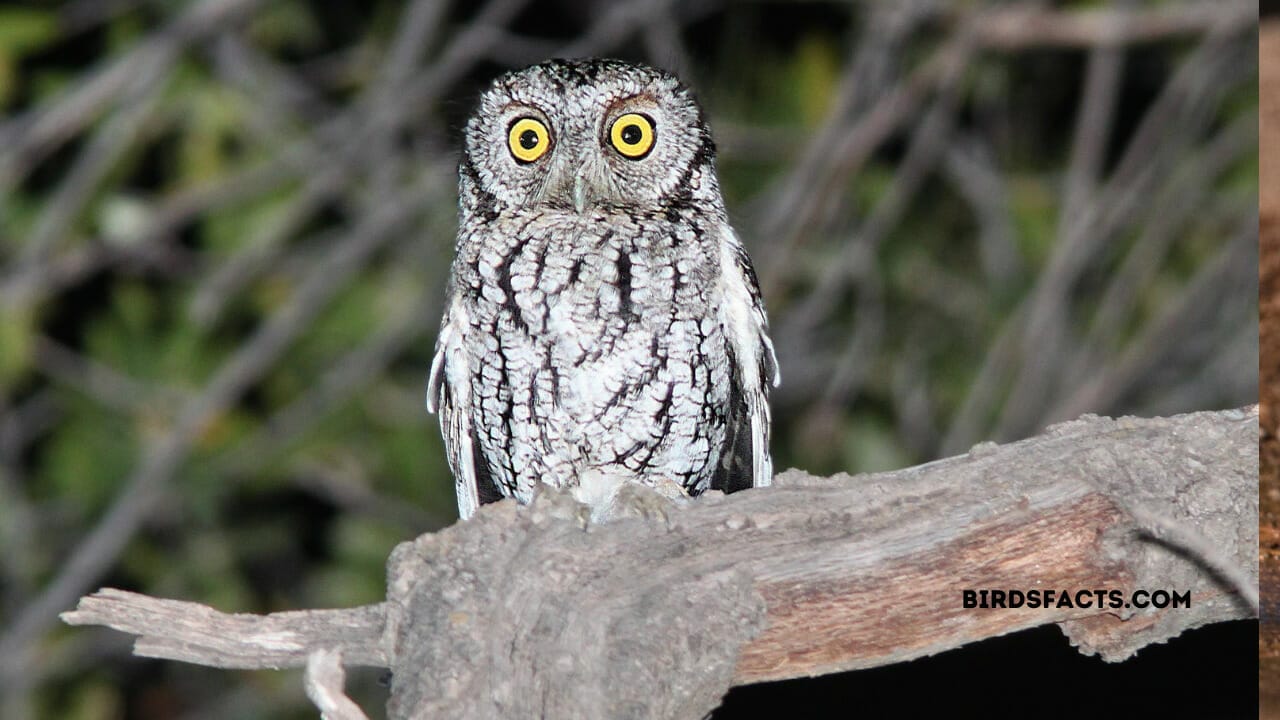
owls of az
The color of their feathers ranges from reddish-brown to gray-brown. They have soft skin, and their top speed is not known due to their nocturnal nature. The Whiskered Screech-Owl has a lifespan of around 15 years, and its weight ranges from 130 -160 grams. They are around 20 – 25 centimeters long, making them a small owl species.
| Attribute | Information |
|---|---|
| Common Name | Whiskered Screech-Owl |
| Scientific Name | Megascops trichiasis |
| Other Names | Trilling Screech-Owl, Tropical Screech-Owl |
| Family | Strigidae |
| Size | Length: 20 – 25 centimeters <br> Wingspan: 41 – 47 centimeters |
| Weight | 130 – 160 grams |
| Lifespan | Approximately 15 years |
| Color | Feathers range from reddish-brown to gray-brown |
| Habitat | Tropical forests to dry and scrubby areas |
| Nesting Locations | Tree cavities |
| Incubation Period | Around 28 days |
| Age of Molting | Around six weeks |
| Diet | Carnivorous – insects, small mammals, and birds |
| Predators | Other birds of prey, snakes |
| Population Size | Estimated population size is not well known, but believed to be stable |
| Threats | Habitat loss and poaching |
| Distinctive Feature | Long, bristly feathers around its beak resembling whiskers |
| Fun Fact | Can rotate its head 270 degrees |
Mexican Spotted owl
The Mexican spotted owl, also known as Strix occidentalis lucida, is a species of owl found in Mexico and the southwestern United States. These birds of prey feed on small mammals, rodents, and insects. A fun fact about them is that they are one of the few owl species active during the day and at night. However, their estimated population size needs to be discovered due to their elusive nature, making it difficult to conduct accurate surveys. The biggest threat to Mexican spotted owls is habitat loss and fragmentation caused by urbanization, logging, and wildfires.
The most distinctive feature of these owls is their chocolate-brown feathers with white spots, which help them blend in perfectly with the rocky canyons and mesas where they live. Other names for this species include the Canyon Owl and the Brown Owl. Their wingspan can reach up to 43 inches, and the incubation period for their eggs is around 30 days. Mexican spotted owls prefer to live in old-growth forests and rocky canyons, where they can build their nests on ledges or in tree cavities. Their predators include larger birds of prey and snakes.
Their diet consists primarily of small mammals like mice and voles, but they may also eat reptiles, birds, and insects. Mexican spotted owls are a type of true owl and one of North America’s largest owl species. They are the sole representative of the genus Strix in Mexico. The Mexican spotted owl has three recognized subspecies, but all are considered endangered. They can be found in Arizona, New Mexico, Utah, and Colorado, with a small population in Mexico.
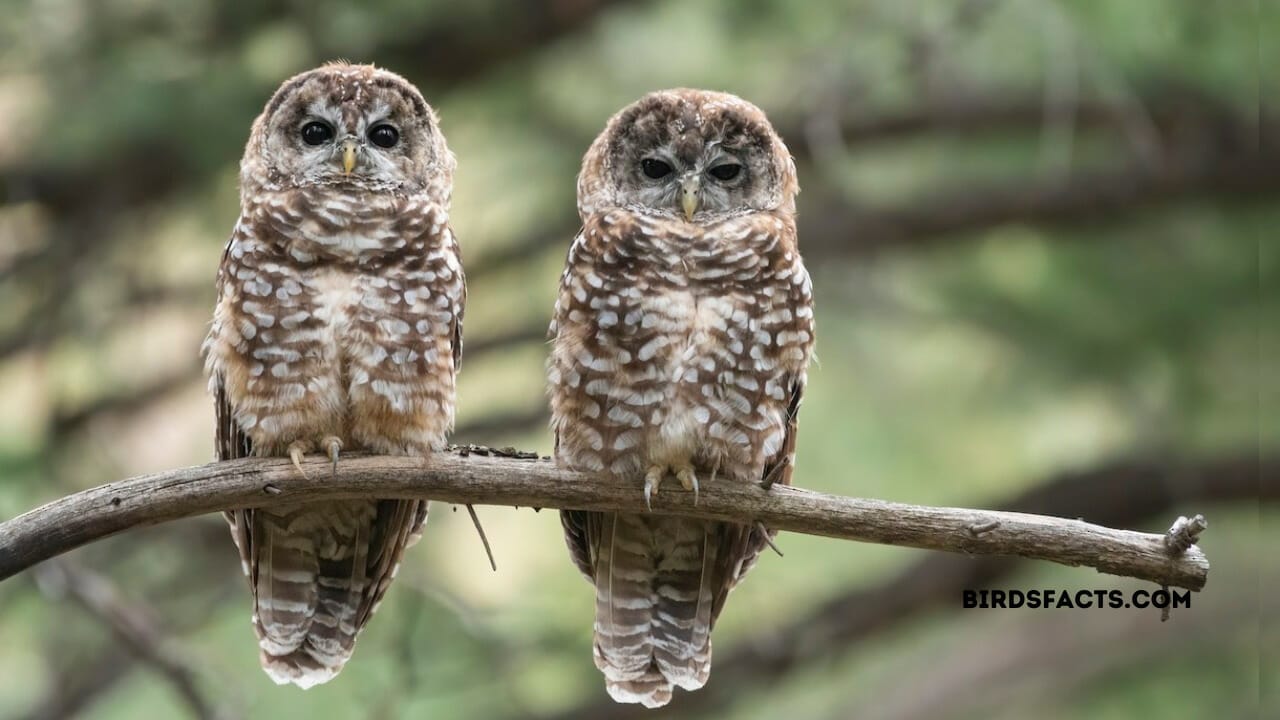
owls in arizona desert
Mexican spotted owls prefer to nest in tree cavities but may also use rock crevices or caves. They can molt and regrow their feathers starting at around six months of age, and their feathers are generally brown with white spots underneath. Their lifespan can reach up to 20 years in the wild. The weight of an adult Mexican spotted owl can range from 500 to 900 grams, and their length can be up to 45 centimeters. These owls are considered a medium-sized owl species, with females being larger than males.
| Topic | Information |
|---|---|
| Species | Mexican spotted owl |
| Scientific Name | Strix occidentalis lucida |
| Habitat | Old-growth forests, rocky canyons, mesas |
| Distribution | Mexico, southwestern United States (Arizona, New Mexico, Utah, Colorado), small population in Mexico |
| Daytime Activity | Yes |
| Feeding Habits | Small mammals, rodents, insects |
| Threats | Habitat loss and fragmentation (urbanization, logging, wildfires) |
| Distinctive Features | Chocolate-brown feathers with white spots |
| Other Names | Canyon Owl, Brown Owl |
| Wingspan | Up to 43 inches |
| Incubation Period | Around 30 days |
| Nesting Preferences | Tree cavities, rock crevices, caves |
| Predators | Larger birds of prey, snakes |
| Diet | Primarily small mammals (mice, voles), also reptiles, birds, insects |
| Genus | Strix |
| Subspecies | Three recognized subspecies (all endangered) |
| Feather Color | Brown with white spots (underside) |
| Lifespan | Up to 20 years in the wild |
| Weight | 500 to 900 grams (adult) |
| Length | Up to 45 centimeters |
| Size Classification | Medium-sized owl species |
| Sexual Dimorphism | Females larger than males |
Northern Pygmy Owl
The Northern Pygmy Owl, scientifically known as Glaucidium californicum, is a small bird of prey found in North America. As their name suggests, they are the smallest species of owl in North America and are known for their distinctive appearance and behavior. These owls typically prey on small mammals, birds, and insects. One fun fact about Northern Pygmy Owls is that they can mimic the calls of other birds, which they use to attract prey or defend their territory.
Despite their small size, they are known to be aggressive towards larger birds and animals. It is estimated that the population size of these owls is stable. The biggest threat to their population is habitat loss due to deforestation and urbanization. The most distinctive feature of the Northern Pygmy Owl is its small size and large head with bright yellow eyes. They are also known as Mountain Pygmy Owls. These birds have a wingspan of around 14 inches and incubation of around 28 days. They can be found in various habitats, including coniferous forests, mixed forests, and wooded areas. Predators of the Northern Pygmy Owl include larger birds of prey, particularly eagles and hawks.
Their diet primarily consists of small mammals and insects. They are classified as raptors, or birds of prey, and are commonly known as Pygmy Owls. There are three species of Pygmy Owls, and the Northern Pygmy Owl is the only one found in North America. They are found throughout the western United States, Canada, and Mexico. These owls typically nest in cavities or abandoned nests in trees. They begin molting or losing their feathers at around one year of age. Their coloration ranges from brown to gray with white spots and streaks.
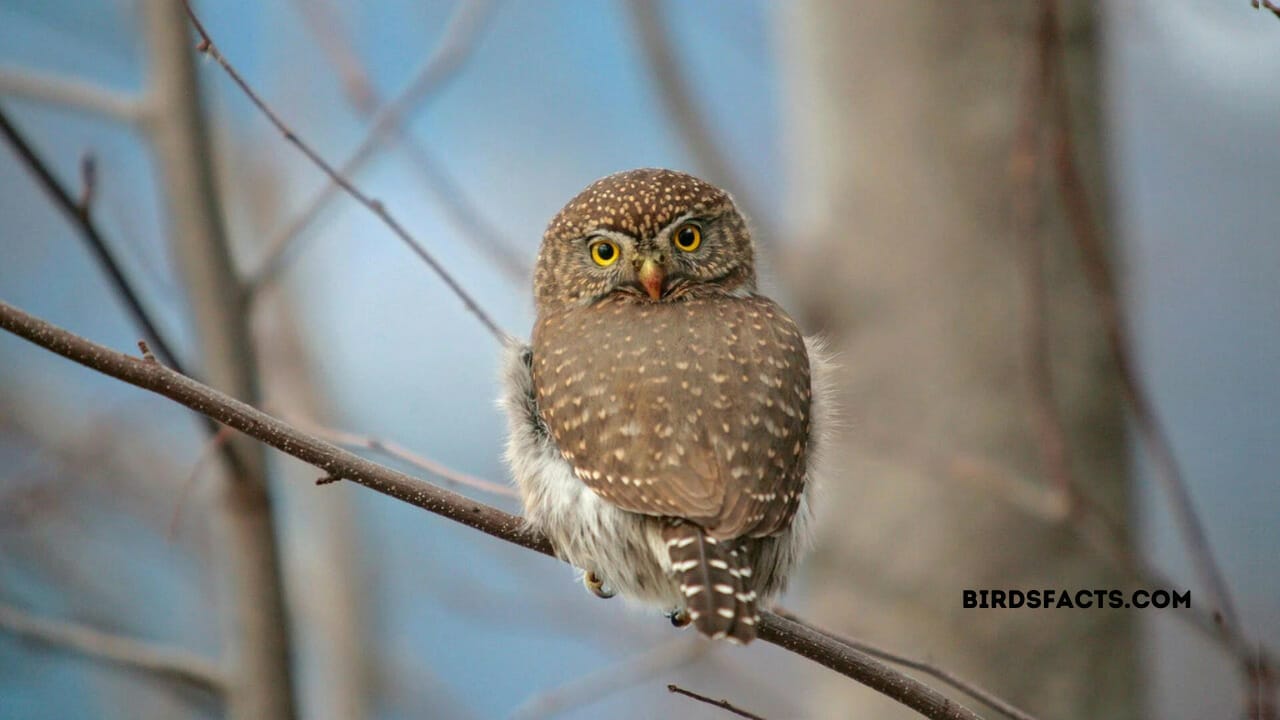
Northern Pygmy Owl
They have feathered skin and can fly at a top speed of around 20 miles per hour. The lifespan of a Northern Pygmy Owl is around 7-10 years in the wild. They typically weigh around 2 ounces and are around 6 inches in length. Despite their small size, the Northern Pygmy Owl is a fascinating and important part of the ecological landscape of North America.
| Characteristic | Information |
|---|---|
| Scientific name | Glaucidium californicum |
| Common name | Northern Pygmy Owl |
| Size | Smallest owl species in North America |
| Habitat | Coniferous forests, mixed forests, wooded areas |
| Distribution | Western United States, Canada, Mexico |
| Diet | Small mammals, birds, insects |
| Predators | Larger birds of prey, particularly eagles and hawks |
| Distinctive features | Small size, large head with bright yellow eyes, brown to gray coloration with white spots |
| Behavior | Aggressive towards larger birds and animals, mimics the calls of other birds |
| Nesting | Cavities or abandoned nests in trees |
| Wingspan | Approximately 14 inches |
| Incubation period | Around 28 days |
| Lifespan | 7-10 years in the wild |
| Weight | Around 2 ounces |
| Length | Approximately 6 inches |
| Threats | Habitat loss due to deforestation and urbanization |
| Conservation status | Stable population size |
Ferruginous Pygmy Owl
The Ferruginous Pygmy Owl, also known as Glaucidium brasilianum, is a small owl species found in the forests of North and South America. This tiny owl feeds mainly on insects, rodents, and small birds and is known for having a distinctive call that sounds like a whistled “woop-woop.” Despite their small size, Ferruginous Pygmy Owls are fierce predators known to take down prey that outweighs them.
One fun fact about these owls is that they have a unique defense mechanism – when threatened, they will raise the feathers on their head to give the illusion of having ears, making them look more intimidating to potential predators. Although these 13 species are not currently facing significant population threats, the estimated population size is still being determined due to their elusive nature and difficulty studying them.
Their biggest threat is habitat loss and destroying their preferred forested habitats. The Ferruginous Pygmy Owl is easily recognized by its unusual ear tufts, which are not ears but rather tufts of feathers. Other names for this species include the Ferruginous Owl or the Rusty Owl. They have a wingspan of about 14 inches, and incubation lasts for around 28 days.
Ferruginous Pygmy Owls are typically found in dense forests with plenty of cover and prey for hunting. Their predators include larger birds of prey, such as hawks and eagles. This species is classified as a carnivore and feeds mainly on insects, small mammals, and birds.
There are 31 species of pygmy owls, and the Ferruginous Pygmy Owl is one of the most common. They can be found across an extensive range, from Central and South America to as far north as Arizona and Texas. These owls prefer to nest in tree cavities or abandoned woodpecker holes and begin molting around 6-8 weeks old.
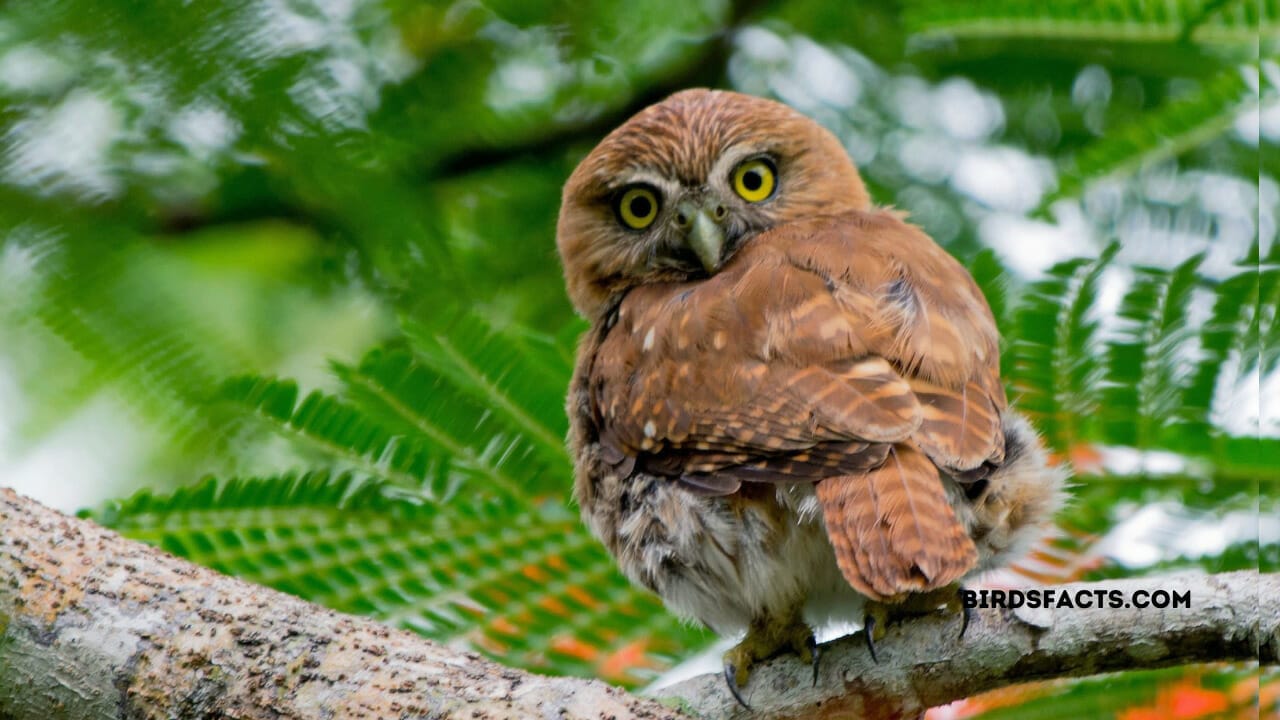
Ferruginous Pygmy Owl
Ferruginous Pygmy Owls have brownish-red coloration, with white spots on their back and belly. They have a smooth skin type and a top speed of around 25 miles per hour. With a lifespan of up to 7 to 9 years, they typically weigh around 2-3 ounces and measure about 6-7 inches in length. Overall, this small but mighty owl is a fascinating species that can be found in a variety of habitats throughout the Americas.
| Common Name | Ferruginous Pygmy Owl |
|---|---|
| Scientific Name | Glaucidium brasilianum |
| Habitat | Forests of North and South America |
| Main Diet | Insects, rodents, small birds |
| Distinctive Call | Whistled “woop-woop” |
| Defense Mechanism | Raises feathers on head to appear more intimidating |
| Population Threats | Habitat loss, destruction of forested habitats |
| Other Names | Ferruginous Owl, Rusty Owl |
| Wingspan | Approximately 14 inches |
| Incubation Period | Around 28 days |
| Preferred Habitat | Dense forests with cover and prey availability |
| Predators | Larger birds of prey (hawks, eagles) |
| Species Classification | Carnivore |
| Range | Central and South America, as far north as Arizona and Texas |
| Nesting Preference | Tree cavities or abandoned woodpecker holes |
| Molting Age | Around 6-8 weeks old |
| Coloration | Brownish-red with white spots on back and belly |
| Skin Type | Smooth |
| Top Speed | Around 25 miles per hour |
| Lifespan | Up to 7-9 years |
| Size | Approximately 6-7 inches in length, 2-3 ounces in weight |
Flammulated Owl
The Flammulated Owl, or Psiloscops flameouts, is a small species of owl that inhabits the western parts of North America. They have a distinctive feature of dark feather tufts on their heads that resemble flames, giving them their name. Despite being small, they have an enormous wingspan of around 18 to 21 inches. These owls usually prefer high-altitude forests for their habitat, where they grow and molt their feathers. They primarily feed on insects but have also been known to hunt small mammals and other birds. Their incubation lasts for around 28 to 30 days, after which the young ones stay in their nesting location from 24 to 28 days before they start molting.
The Flammulated Owl is often preyed upon by larger birds like eagles and hawks, and their biggest threat besides predators is the loss of their natural habitat due to deforestation and urbanization. The estimated population size of this species is around 1.5 million individuals, but their numbers have decreased over the years. A fun fact about these birds is that they are proficient in flying at night, even in complete darkness. They have a top speed of around 35 miles per hour, making them one of the swiftest owls.
The Flammulated Owl is, also known as the Flame Owl, one of the smallest owl species in North America. They have a reddish-brown body with a round face and yellow eyes. Their skin type is soft, and their feathers are fluffy.
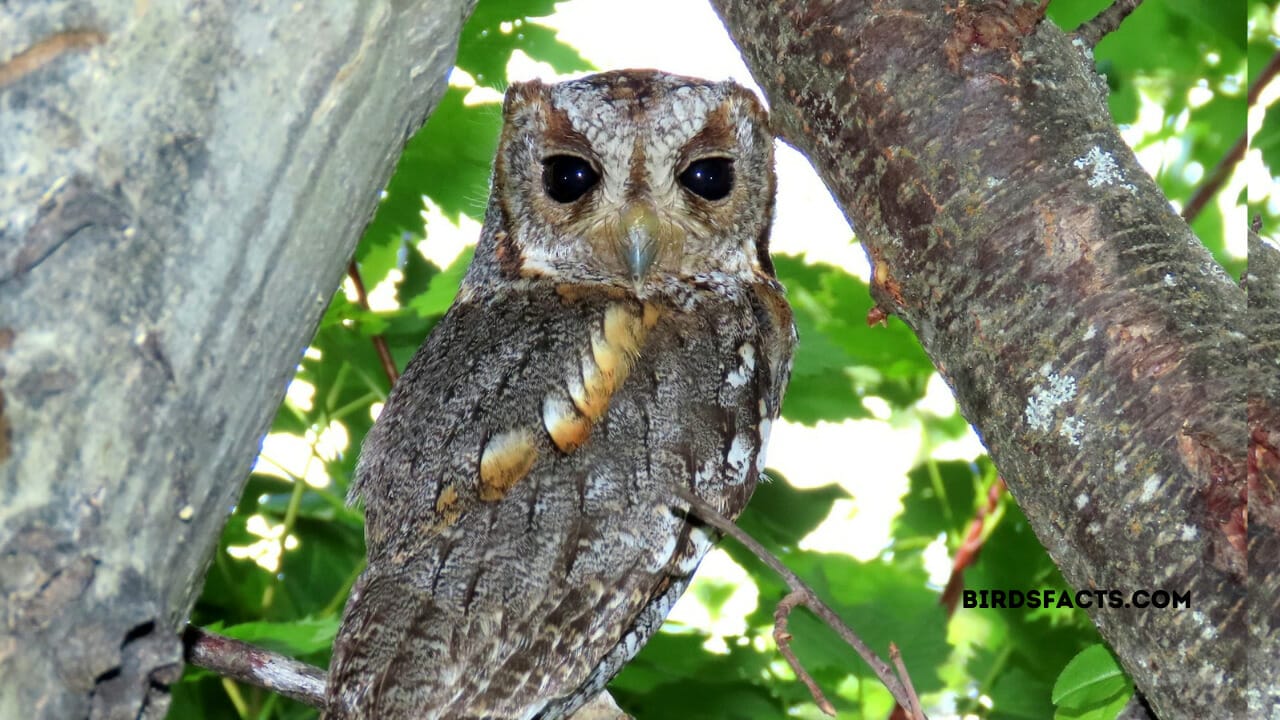
white owls in arizona
The color of their plumage blends in with their surroundings, providing them with camouflage and protection from predators. The average lifespan of these birds is around six years, and they weigh between 56 to 85 grams. Overall, the Flammulated Owl is a fascinating species with unique features and characteristics that make it stand out in the owl family.
| Species Name | Flammulated Owl |
|---|---|
| Scientific Name | Psiloscops flameouts |
| Habitat | Western parts of North America |
| Distinctive Feature | Dark feather tufts on their heads resembling flames |
| Wingspan | 18 to 21 inches |
| Preferred Habitat | High-altitude forests |
| Primary Diet | Insects, small mammals, and other birds |
| Incubation Period | 28 to 30 days |
| Nesting Period | 24 to 28 days |
| Predators | Larger birds like eagles and hawks |
| Threats | Loss of natural habitat due to deforestation, urbanization |
| Population Size | Approximately 1.5 million individuals |
| Fun Fact | Proficient in flying at night, even in complete darkness |
| Top Speed | Around 35 miles per hour |
| Size | One of the smallest owl species in North America |
| Body Color | Reddish-brown |
| Facial Features | Round face, yellow eyes |
| Skin Type | Soft |
| Feather Characteristics | Fluffy |
| Lifespan | Around six years |
| Weight | 56 to 85 grams |
Burrowing Owl
The Burrowing Owl, scientifically known as Athene cunicularia, is a small and unique species of owl found across North and South America. They primarily feed on insects, rodents, and small mammals. Interestingly, these owls are known for their quirky habit of using animal dung to mark their territories. One of their most distinctive features is their long legs, used for digging and burrowing into the ground.
They are also known as Prairie Owl or Ground Owl due to their preference for living in caves in open grasslands. Burrowing owls have a wingspan of around two feet and typically incubate their eggs for about five weeks. These owls are threatened by habitat destruction and human intervention. They are also vulnerable to larger predators such as foxes, coyotes, and birds of prey. Unlike many other owl species, burrowing owls are diurnal hunters, meaning they hunt for food during the day. They are also considered a “species of concern” by the United States Fish and Wildlife Service due to their decreasing population size caused by habitat destruction and fragmentation.
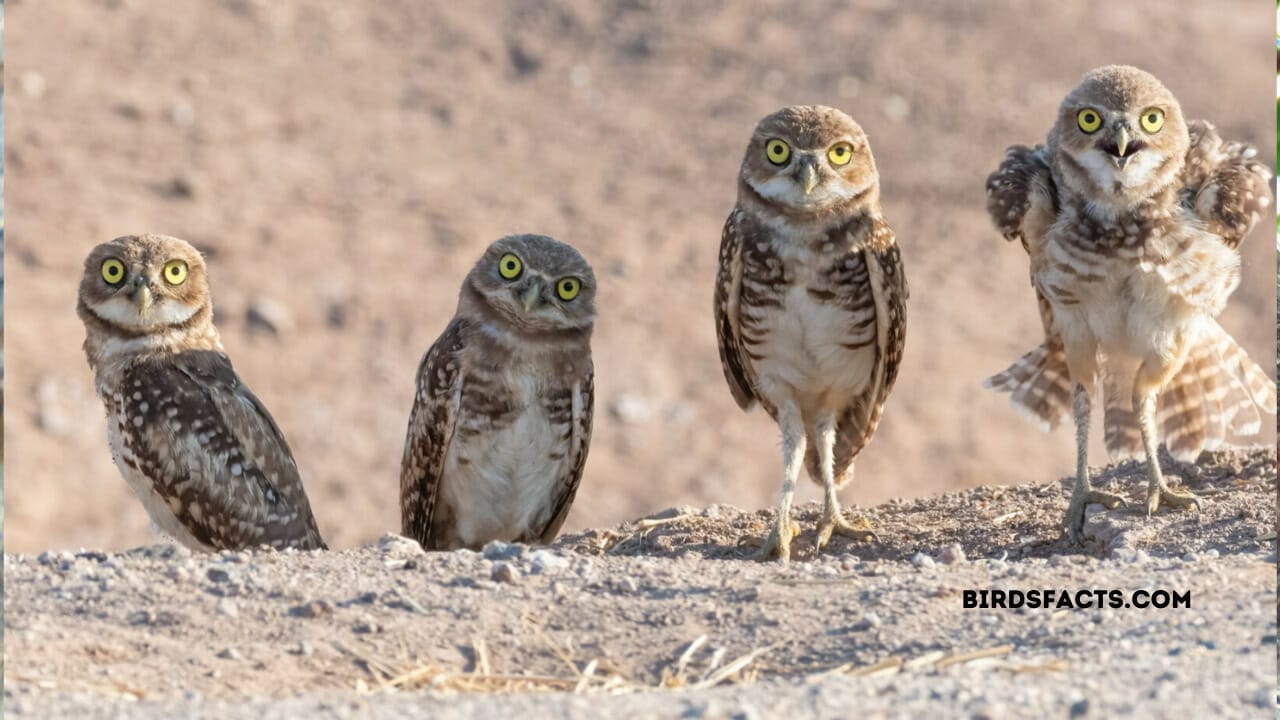
arizona owls phoenix
The burrowing owl’s average lifespan is about four to five years, and its top speed is around twenty miles per hour when flying. They typically weigh between four and eight ounces and can grow to around ten inches. These unique birds molt around one year, and their feathers come in a range of colors from brown to gray with white spotting.
| Species Name | Burrowing Owl |
|---|---|
| Scientific Name | Athene cunicularia |
| Habitat | North and South America |
| Diet | Insects, rodents, small mammals |
| Territory Marking | Use of animal dung |
| Distinctive Feature | Long legs for digging and burrowing |
| Alternative Names | Prairie Owl, Ground Owl |
| Preferred Habitat | Caves in open grasslands |
| Wingspan | Approximately two feet |
| Incubation Period | Around five weeks |
| Threats | Habitat destruction, human intervention |
| Predators | Foxes, coyotes, birds of prey |
| Hunting Behavior | Diurnal (hunt during the day) |
| Conservation Status | “Species of concern” by US Fish and Wildlife Service |
| Lifespan | Four to five years |
| Top Speed | Approximately twenty miles per hour (in flight) |
| Weight | Four to eight ounces |
| Size | Around ten inches |
| Molting | Occurs around one year |
| Feather Colors | Range of colors from brown to gray with white spotting |
Elf Owl
The Elf Owl, also known as Micrathene Whitney, is one of the smallest owl species in the world. It is about the size of a sparrow, reaching a length of only five inches and weighing less than one ounce. Despite its size, this owl is a fierce predator, feeding on insects, small rodents, and occasionally small birds. A fun fact about the Elf Owl is that it earned its name due to its resemblance to an elf from folklore.
Furthermore, the Elf Owl is primarily found in the southwestern United States and Mexico, with an estimated population size of around 30,000 to 100,000 individuals. The biggest threat to the Elf Owl is habitat loss and competition with other cavity-nesting birds for a limited number of nesting locations. The most distinctive feature of the Elf Owl is its large eyes about its small body size. This species is also known as the Whitney’s Micrathene and has a wingspan of only around 10 inches. The Elf Owl incubates its eggs for around three to four weeks, with the young reaching maturity after about five months.
Its habitat ranges from desert scrub to oak and pine forests, and its predators include larger birds of prey, snakes, and mammals such as coyotes. The diet of the Elf Owl is primarily composed of small insects, but it occasionally consumes vertebrates such as lizards and small snakes. The Elf Owl is a type of typical owl and is classified within the Strigidae family. There is only one species of Elf Owl, and it can be found in various locations in the southwestern United States and Mexico.

do owls live in the desert
The Elf Owl has a lifespan of up to six years in the wild and molts for the first time at around six weeks old. The color of the Elf Owl is a mix of gray and tan, and its skin type is feathered. The top speed of the Elf Owl is unknown, but it is thought to be relatively slow in flight.
| Fact | Information |
|---|---|
| Common Name | Elf Owl |
| Scientific Name | Micrathene Whitney |
| Size | Approximately 5 inches (length) and less than 1 ounce (weight) |
| Predatory Behavior | Feeds on insects, small rodents, and occasionally small birds |
| Resemblance | Resembles an elf from folklore |
| Habitat | Southwestern United States and Mexico |
| Population Estimate | 30,000 to 100,000 individuals |
| Threats | Habitat loss and competition for nesting locations |
| Distinctive Feature | Large eyes compared to small body size |
| Wingspan | Approximately 10 inches |
| Incubation Period | Around 3 to 4 weeks |
| Time to Maturity | Approximately 5 months |
| Habitat Range | Desert scrub, oak, and pine forests |
| Predators | Larger birds of prey, snakes, and coyotes |
| Diet | Primarily small insects, occasionally lizards and small snakes |
| Family | Strigidae |
| Species | One species |
| Lifespan | Up to 6 years in the wild |
| First Molt Age | Around 6 weeks old |
| Coloration | Mix of gray and tan |
| Skin Type | Feathered |
| Flight Speed | Unknown (thought to be relatively slow) |
Conclusion
Owls in Arizona is home to an incredible array of owl species, each with unique characteristics and adaptations. From the powerful Great Horned Owl to the tiny Elf Owl, these captivating creatures enrich our ecosystems and evoke a sense of wonder. By appreciating and safeguarding their habitats, we can ensure the continued existence of these remarkable species for future generations to admire. Embark on your owl-watching adventures in Arizona, and let the allure of these majestic birds inspire you.
What is the most common owl in Arizona?
What is the most common owl in Arizona? The most common owl species in Arizona is the Western Screech Owl. These tiny owls can be found in various habitats, including deserts, forests, and urban areas. They are adapted to living in regions with high temperatures and low humidity and are often active both day and night. Despite their familiar presence in the state, Western Screech Owls are rarely seen due to their nocturnal habits and excellent camouflage.
Is it reasonable to have an owl in your yard?
Having an owl in your yard is beneficial. Owls are natural predators and can help control the population of rodents and other pests in your yard. They also provide a unique and exciting addition to the natural wildlife in your area. However, it is essential to remember that owls are wild animals and should not be approached or disturbed. It is best to enjoy their presence from a safe distance.
What is the most common owl to see?
What is the most common owl to see? The most common owl to see is the barn owl. Barn owls are found worldwide and are easily recognizable by their heart-shaped face and white feathers. They are often found in rural areas, and their diet consists mainly of small mammals like mice and voles. Despite their popularity, barn owls are still threatened by habitat loss and pesticides.
Further Reading
You may also check out:
- Red Headed Bird Hawaii
- Black Bird White Stripes On Wings
- Two Harbors Eagle Cam
- Finches in Texas
- iBoy Ramdisk Tool
Thank you for reading!








